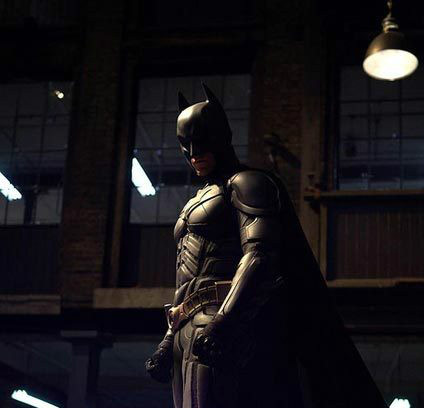Holy Therapists! Why Batman Drives Shrinks Batty

NEW YORK – No real psychiatrist has ever gotten the chance to diagnose and treat Batman, but they'd likely have as little luck as any of their fictional counterparts in Gotham City. A strong anti-psychiatry bias in the Batman comic book universe may even be why readers and moviegoers love the dark knight so much, according to a psychiatrist at New York Comic Con.
Psychiatrists and cognitive neuroscientists not only fail to stem the tide of mentally unbalanced supervillains that Batman fights, but often end up becoming villains themselves. That depiction may work so well because people often do feel uneasy around their head shrinks. [Related: Superhero or Supervillain: Which Lurks Inside You?]
"The fact is that therapists are pretty creepy people," said Daniel Debowy, a psychiatrist at North Suffolk Community Mental Health in Boston and a self-described Batman fan.
Debowy spoke during a panel called "Psychiatry and the Superhero" at New York Comic Con last Friday. He listed several reactions he had gotten from patients in real life, including aggressive questions about why he didn't get mad or why he never smiled.
Psychiatrists have also had a rocky relationship with comic books in the past, Debowy pointed out. He argued that the harsh treatment of psychiatry at the hands of Batman writers actually reflects payback for how psychiatrists demonized comic books during the 1950s.
A history of violence
A major clash between psychiatry and comic books arose when the Senate Subcommittee on Juvenile Delinquency held hearings in 1954 about whether comic books were corrupting America's youth. At least one psychiatrist testified in defense of DC Comics, but several more gave darker testimony about the influence of comic books.
Get the world’s most fascinating discoveries delivered straight to your inbox.
Those hearings led to the infamous Comic Code Authority, a self-censorship body created by the Comics Magazine Association of America that regulates the content of comic books. Among other things, the 1954 version of the code forbade excessive violence, prohibited a sympathetic view toward criminals, and banned anything that might promote distrust of authority figures or law enforcement.
How much do you trust head shrinks?online surveys
The sanitized Batman comic books created during that era gave rise to the goofier Batman TV series of the 1960s embodied by actor Adam West. But comic book writers began rebelling during the 1960s and 1970s, so that the Comic Code finally began undergoing revisions. An easing up on censorship meant that writers could begin turning the tables on psychiatrists by casting nefarious characters in the Batman comic books.
At the same time, the public began to experience some disillusionment with the mental health profession. Liberal outrage ensued over notable cases of psychiatrists abusing their out-patients, and institutional reforms began in response to cases of patients being held indefinitely or being treated inhumanely. Similarly, conservatives suspected that psychiatrists merely gave an excuse to criminals for their bad behavior and freed them to continue wreaking havoc as U.S. crime rates rose.
Gone bad to the bone
The real world distrust and backlash prompted a new cast of villains for Batman to fight, including some characters such as the Mad Hatter who were given background knowledge of brain science. Such villains proceeded to break just about every ethical code for mental health professionals, Debowy said.
Jonathan Crane, also known as "The Scarecrow," abuses his clinical knowledge of drugs and psychology to terrorize Gotham residents. Another villainous psychiatrist, Hugo Strange, turns patient confidentiality on its head by blackmailing his wealthy clients with their secrets.
Debowy cited Harley Quinn as a personal Batman favorite example. First known as Harleen Frances Quinzel, her character is a psychologist working at Arkham Asylum who breaches the professional code against patient intimacy by falling in love with the demented Joker.
All these villains regularly cycle through Gotham's Arkham Asylum when caught by Batman, but typically escape once again to continue their rampages — making Arkham Asylum a "revolving door of injustice," Debowy observed. That itself mocks the mental health profession's ability to deal with the troubles plaguing the Batman universe.
How Batman stays sane
Despite all this, Batman protagonist Bruce Wayne manages to take down the villains and even overcome his own personal trauma of losing his parents in a double homicide. But his manner of coping hardly qualifies as normal — donning the Batman costume to fight criminals as a masked vigilante.
That makes Batman an optimistic figure that can not only survive but thrive despite his mental health issues, Debowy suggested. Furthermore, the strange Batman proves the only force capable of dealing with Gotham City's cast of supervillains with serious issues. [Related: The Psychology of Darth Vader Revealed]
"He manages to cope and be effective, showing resilience without ever walking into a psychologist's office or taking a pill," Debowy explained. "He just lives his life."
That example shows how Batman accepts his strangeness and dares readers to do the same — an acceptance of how overcoming mental health issues may always represent a work-in-progress, Debowy pointed out.
"If patients can see that, my job is pretty easy," Debowy said.



